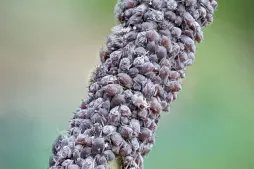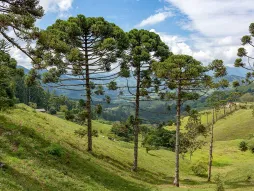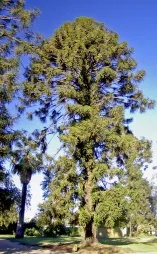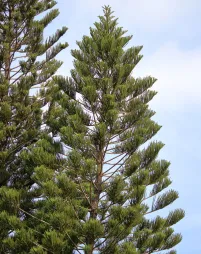Araucaria heterophylla, Norfolk pine
Native to Norfolk Island in south-western Australia, Araucaria heterophylla is also found in coastal regions with mild winters and in our homes. This member of the Araucariaceae family can be recognized by its symmetrical spire and ever-straight trunk.
How to recognize Araucaria heterophylla, the Norfolk pine?
Araucaria heterophylla is an evergreen tree with a conical habit. It reaches a height of 70 meters on its native island. Grown in pots and indoors, it doesn't exceed two meters in height and a 1.5-meter spread.
While araucaria columnaris has a leaning trunk, the Norfolk pine's trunk always remains straight, even when subjected to the strong winds that blow by the sea. Its branches are slightly upright, with perfect symmetry at the top. This is why the top of the Araucaria heterophylla is often used as a Christmas tree.
Young Norfolk pines have light-green needles. Fine and pointed, they measure just 1.5 centimetres long and one millimetre thick. In older conifers, the leathery leaves become longer and thicker. They measure up to ten centimetres long and four millimetres thick.
Only the female cones are visible on the tree. The globular pine cones contain the winged seeds that enable Araucaria heterophylla to multiply.
The seeds are edible, and the rest of the plant is non-toxic if touched or ingested. Beware, however, of the needles, which can be prickly!
Our maintenance tips
Araucaria heterophylla need space. Plant them in the ground, away from other crops, so they can flourish. Once established, they'll be virtually maintenance-free.
Watering
Araucaria heterophylla needs a regular supply of water. But, like many plants, the plant cannot tolerate excess. Check that the potting soil has dried on the surface (two to three centimetres) before watering. If this is the case, use non-calcareous water at room temperature. You only need to moisten the root ball, not the soil.
Don't forget to drain off any stagnant water in the saucer or planter. It could rot the roots.
Repotting
Get a pierced pot. Its size depends on your situation. If you've just bought your Norfolk pine, the container should be twice the size of the root ball. If you've already repotted the plant, one size larger than the previous pot will suffice.
Place a layer of universal potting soil on the bottom. Plant your Norfolk pine in the center. The rootball should be three centimetres below the rim of the pot to form a watering trough. Add substrate and tamp gently.
Water to expel air bubbles and encourage rooting.
Fertilization
You can stimulate the growth of your plant during its growth phase, in spring and summer, with fertilizer.
Fertilize your Norfolk pine with a conifer fertilizer once a month. Follow the dosage and manufacturer's instructions to avoid damaging the foliage.
Place compost at the foot of your Norfolk pine.
Prune
Your Norfolk pine does not need pruning. On the contrary, pruning could be detrimental to its growth.
You can, however, remove dead branches in early summer using a clean, sharp tool, such as pruning shears.
Plantation
Soak your Araucaria heterophylla. Meanwhile, dig a hole twice the size of the root ball. You can place gravel at the bottom to improve drainage.
Plant your Araucaria heterophylla. The collar should reach ground level. Fill the hole with garden soil. But you can also add sand if your soil is heavy, or potting soil if it's poor.
Water generously to encourage rooting and remove air bubbles.
Seedling
Pour seedling soil into pots. Plant two to three seeds per pot.
Keep the substrate moist by spraying regularly.
Diseases / Threats
Information
| Family | Araucariaceae - Araucariaceae |
| Type | Araucaria - Araucaria |
| Species | Araucaria heterophylla - Araucaria heterophylla |
| Lifecycle | Perennial |
| Foliage | Evergreen |
| Exposures | |
| Substrat | |
| Planting methods |
Open ground In pots In tubs |
| Categories | |
| Tags |
Beginner Large pot |
| Origin |
Australia |
| Hardiness (USDA) | 11a |
| Leaf color |
|
| Flower color |
|
| Fruit color |
|
Discover plants from the same family























